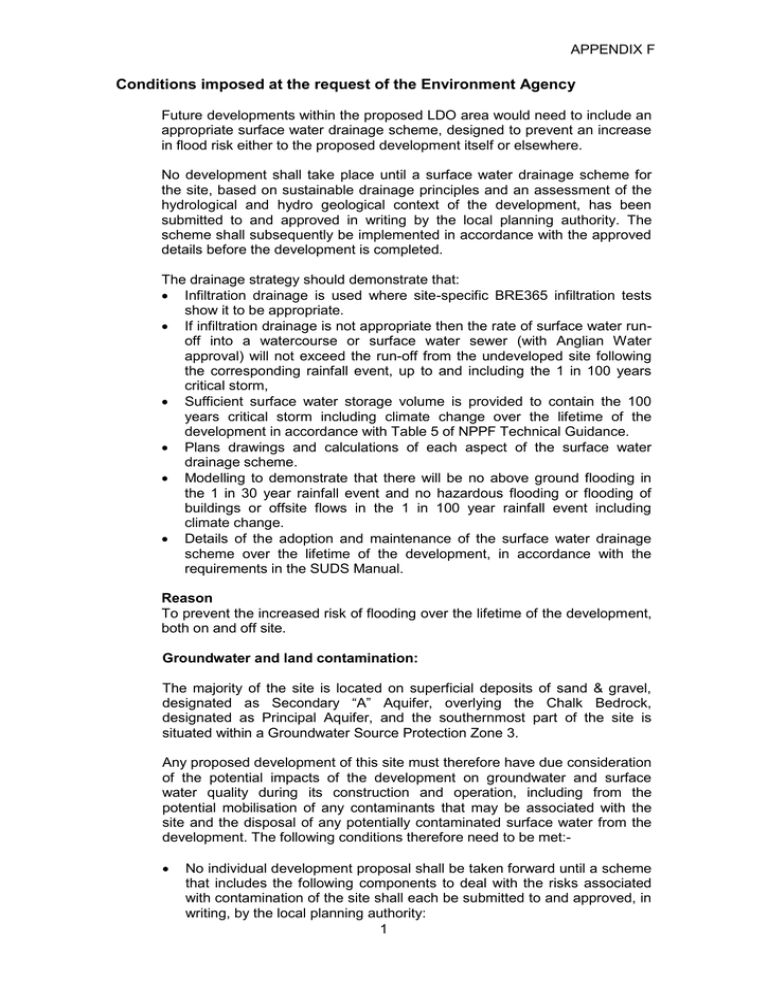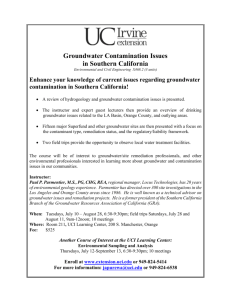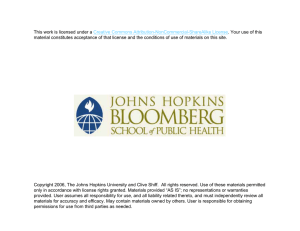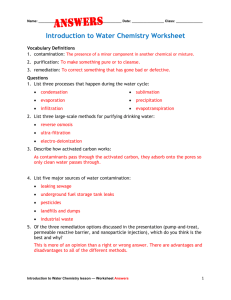Conditions imposed at the request of the Environment Agency
advertisement

APPENDIX F Conditions imposed at the request of the Environment Agency Future developments within the proposed LDO area would need to include an appropriate surface water drainage scheme, designed to prevent an increase in flood risk either to the proposed development itself or elsewhere. No development shall take place until a surface water drainage scheme for the site, based on sustainable drainage principles and an assessment of the hydrological and hydro geological context of the development, has been submitted to and approved in writing by the local planning authority. The scheme shall subsequently be implemented in accordance with the approved details before the development is completed. The drainage strategy should demonstrate that: Infiltration drainage is used where site-specific BRE365 infiltration tests show it to be appropriate. If infiltration drainage is not appropriate then the rate of surface water runoff into a watercourse or surface water sewer (with Anglian Water approval) will not exceed the run-off from the undeveloped site following the corresponding rainfall event, up to and including the 1 in 100 years critical storm, Sufficient surface water storage volume is provided to contain the 100 years critical storm including climate change over the lifetime of the development in accordance with Table 5 of NPPF Technical Guidance. Plans drawings and calculations of each aspect of the surface water drainage scheme. Modelling to demonstrate that there will be no above ground flooding in the 1 in 30 year rainfall event and no hazardous flooding or flooding of buildings or offsite flows in the 1 in 100 year rainfall event including climate change. Details of the adoption and maintenance of the surface water drainage scheme over the lifetime of the development, in accordance with the requirements in the SUDS Manual. Reason To prevent the increased risk of flooding over the lifetime of the development, both on and off site. Groundwater and land contamination: The majority of the site is located on superficial deposits of sand & gravel, designated as Secondary “A” Aquifer, overlying the Chalk Bedrock, designated as Principal Aquifer, and the southernmost part of the site is situated within a Groundwater Source Protection Zone 3. Any proposed development of this site must therefore have due consideration of the potential impacts of the development on groundwater and surface water quality during its construction and operation, including from the potential mobilisation of any contaminants that may be associated with the site and the disposal of any potentially contaminated surface water from the development. The following conditions therefore need to be met: No individual development proposal shall be taken forward until a scheme that includes the following components to deal with the risks associated with contamination of the site shall each be submitted to and approved, in writing, by the local planning authority: 1 APPENDIX F 1) A preliminary risk assessment which has identified: all previous uses potential contaminants associated with those uses a conceptual model of the site indicating sources, pathways and receptors potentially unacceptable risks arising from contamination at the site. 2) A site investigation scheme, based on (1) to provide information for a detailed assessment of the risk to all receptors that may be affected, including those off site. 3) The results of the site investigation and detailed risk assessment referred to in (2) and, based on these, an options appraisal and remediation strategy giving full details of the remediation measures required and how they are to be undertaken. 4) A verification plan providing details of the data that will be collected in order to demonstrate that the works set out in the remediation strategy in (3) are complete and identifying any requirements for longer-term monitoring of pollutant linkages, maintenance and arrangements for contingency action. Any changes to these components require the express written consent of the local planning authority. The scheme shall be implemented as approved. No occupation of any part of the permitted development / of each phase of development shall take place until a verification report demonstrating completion of works set out in the approved remediation strategy and the effectiveness of the remediation shall be submitted to and approved, in writing, by the local planning authority. The report shall include results of sampling and monitoring carried out in accordance with the approved verification plan to demonstrate that the site remediation criteria have been met. It shall also include any plan (a “long-term monitoring and maintenance plan”) for longer-term monitoring of pollutant linkages, maintenance and arrangements for contingency action, as identified in the verification plan. The long-term monitoring and maintenance plan shall be implemented as approved. No development should take place until a long-term monitoring and maintenance plan in respect of contamination including a timetable of monitoring and submission of reports to the Local Planning Authority, shall be submitted to and approved in writing by the Local Planning Authority. Reports as specified in the approved plan, including details of any necessary contingency action arising from the monitoring, shall be submitted to and approved in writing by the Local Planning Authority. Any necessary contingency measures shall be carried out in accordance with the details in the approved reports. On completion of the monitoring specified in the plan a final report demonstrating that all long-term remediation works have been carried out and confirming that remedial targets have been achieved shall be submitted to and approved in writing by the Local Planning Authority. If, during development, contamination not previously identified is found to be present at the site then no further development (unless otherwise agreed in writing with the local planning authority) shall be carried out until the developer has submitted a remediation strategy to the local planning authority detailing how this unsuspected contamination shall be dealt with 2 APPENDIX F and obtained written approval from the local planning authority. The remediation strategy shall be implemented as approved. These conditions are to protect and prevent the pollution of controlled waters (particularly groundwater associated with the Secondary and Principal Aquifers underlying the site from potential pollutants associated with current and previous land uses) in line with National Planning Policy Framework (NPPF; paragraphs 109 and 121), EU Water Framework Directive, Anglian River Basin Management Plan and Environment Agency Groundwater protection: Principles and practice (GP3) 2012 position statements. Surface Water Infiltration Systems: Informative/advice to applicants: Where soakaways or other infiltration systems are proposed for the disposal of surface water, our general requirements are as follows: 1) Soakaways or other infiltration systems shall only be used in areas on site where they will not present a risk to groundwater, with the depth of soakaway kept to a minimum to ensure that the maximum possible depth of unsaturated material remains between the base of the soakaway and the top of the water table, ensuring that a direct discharge of surface water into groundwater is prevented. 2) Soakaways shall not be constructed in land affected by contamination, where they may promote the mobilisation of contaminants and give rise to contamination of groundwater. 3) Only clean water from roofs shall be directly discharged to soakaways. 4) Systems for the discharge of surface water from associated hardstanding, roads and impermeable vehicle parking areas shall incorporate appropriate pollution prevention measures. Drainage to soakaways from car parking areas for >50 spaces should be passed through an oil interceptor before discharging to ground, as should drainage from parking areas that will discharge to a surface watercourse. Further information on the discharge of surface water is available at: http://www.environmentagency.gov.uk/business/topics/water/111878.aspx 5) Subject to the approval of the Local Authority, percolation tests should be undertaken to ensure that soakaways will work adequately in adverse conditions. If, after tests, it is found that soakaways do not work satisfactorily, alternative proposals should be submitted. Pollution prevention: Informative/advice to applicants: In addition to the above, included below are a range of informatives that we would offer in response to proposals for general industrial type development. Some or all of these may apply to development at Egmere: The Environmental Permitting Regulations 2010 make it an offence to cause or knowingly permit a groundwater activity unless authorised by an Environmental Permit which we will issue. A groundwater activity includes any discharge that will result in the input of pollutants to groundwater. 3 APPENDIX F All industrial sites have the potential to cause pollution of the water environment, therefore due consideration should be given to the prevention of pollution as early as possible in the design process. Where it is not possible to connect foul drainage to the main sewer and it is proposed to discharge treated effluent to ground or to a surface watercourse, the applicant may require an Environmental Permit from us under the Environmental Permitting Regulations 2010. A permit will only be granted where the risk to the environment is acceptable. Additional „Environmental Permitting Guidance‟, including when a permit is required, can be accessed via the Environment Agency‟s main website http://www.environment-agency.gov.uk/business/topics/water/32038.aspx Proposals involving non-mains drainage should be considered with regard to the advice in DETR Circular 3/99. Regarding oil storage, in England, the storage of oil (except waste oils) is regulated under the Control of Pollution (Oil Storage) (England) Regulations 2001. The regulations apply to industrial, commercial and institutional sites storing more than 200 litres of oil and private dwellings storing more than 3,500 litres. The regulations require that any facilities for the storage of oils, fuels or chemicals shall be provided with secondary containment that is impermeable to both the oil, fuel or chemical and water, for example a bund, details of which shall be submitted to the local planning authority for approval. The minimum volume of the secondary containment should be at least equivalent to the capacity of the tank plus 10%. If there is more than one tank in the secondary containment the capacity of the containment should be at least the capacity of the largest tank plus 10% or 25% of the total tank capacity, whichever is greatest. All fill points, vents, gauges and sight gauge must be located within the secondary containment. The secondary containment shall have no opening used to drain the system. Associated above ground pipe work should be protected from accidental damage. Below ground pipe work should have no mechanical joints, except at inspection hatches and either leak detection equipment installed or regular leak checks. All fill points and tank vent pipe outlets should be detailed to discharge downwards into the bund. More information on the minimum legal requirements is available in „Above ground oil storage: PPG 2‟. Additional general information, including advice contained our all Pollution Prevention Guidance notes (PPGs), is available at: http://www.environmentagency.gov.uk/business/topics/pollution/39083.aspx We would also recommend that developers follow the advice within our publication “Pollution Prevention Pays: Getting Your Site Right” which is available for free from our website at: http://www.environmentagency.gov.uk/business/topics/pollution/36641.aspx 4









